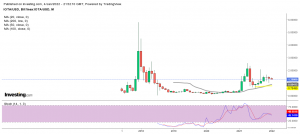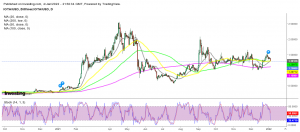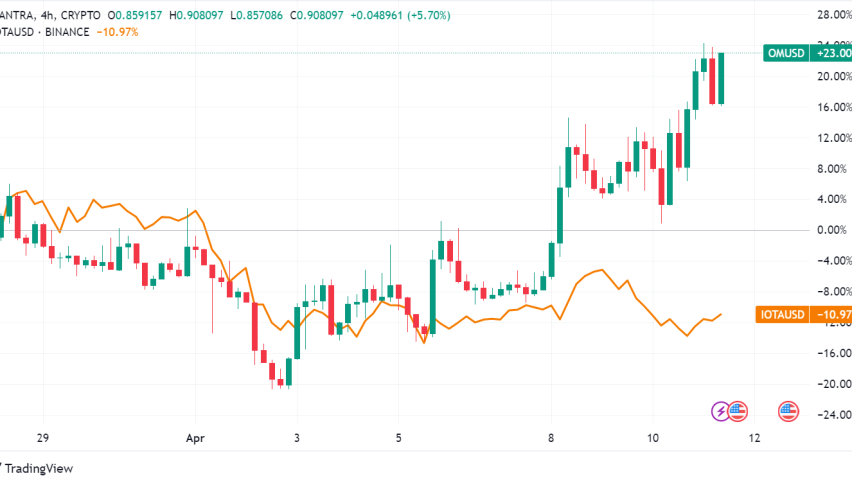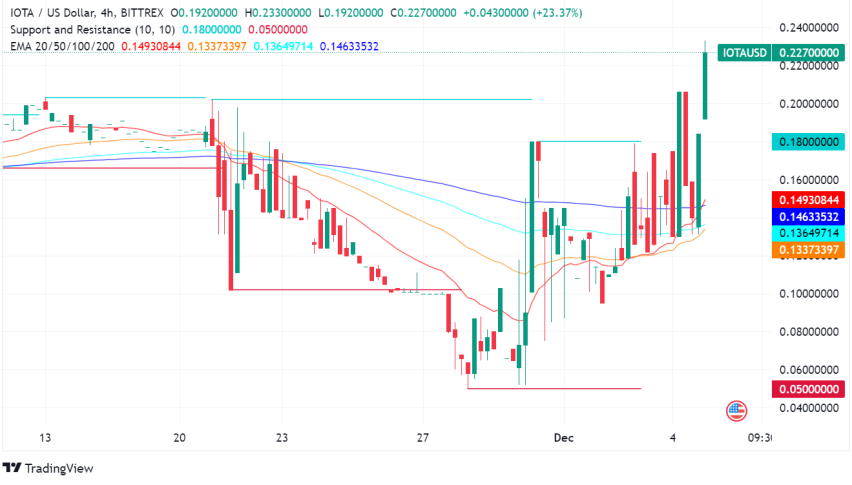IOTA – Forecast Summary
| IOTA Forecast: H2 2021 Price: $0.80-$1.00 Price drivers: Crypto market sentiment, IOTA sentiment, Crypto market sentiment | IOTA Forecast: 1 Year Price: $1.50 – $2.50 Price drivers: Central banks policy, Global economic recovery, COVID-19 | IOTA Forecast: 3 Years Price: $5.00- $10.00 Price drivers: Crypto market, IOTA adoption, Global politics |
IOTA was launched in 2017, which was a very good time, as the attention was turning to the crypto market, and it made an impressive presentation into the crypto world, as it surged from $0.30 to $5.80 by December that year. After coming down with the market in 2018, IOTA traded sideways near the bottom at around $0.30 for a few years, until the first several months of 2021 when the crypto market surged higher.
IOTA increased to $2.57, although the crackdown in cryptocurrencies in China sent digital coins plunging again in May last year. But while other cryptocurrencies have recuperated well since August 2021, IOTA has failed to attract attention in the crypto world, trading sideways. So, despite IOTA being the currency for the Internet of Things in the future, right now there’s nothing promising for IOTA.
Recent Changes in the IOTA Price
| Period | Change ($) | Change % |
| 1 Month | -0.10 | -8.4% |
| 3 Months | -0.26 | -19.5% |
| 6 Months | +0.23 | +37.7% |
| 1 Year | +0.33 | +71% |
| 3 Years | +0.70 | +224% |
Factors Affecting IOTA
IOTA has been following the market sentiment since it was launched. It has been one of the main factors affecting the IOTA price since 2017 although it seems like this correlation has been eroding since summer of 2021. IOTA has increased in value when crypto the market has been bullish, and vice-versa, but it has failed to capitalize on the positive sentiment in Q3 of 2021. The market sentiment in itself has been a fight between investor appetite and the crackdown on cryptocurrencies during 2021. Although, investors are looking deeper into IOTA which is a bit if an empty network right now, so they have refrained from investing in recent months, hence the sideways price action.
The implementation of the Internet of Things (IoT) has picked up pace since the beginning of the COVID-19 pandemic, but despite IOTA being the system for IoT transactions, it hasn’t benefited from that either, which raises questions for investors. At least, moving averages have turned from support into resistance on larger period charts, so let’s hope they will offer support for IOTA.
IOTA Price Prediction for the Next 5 Years
While certain markets performed well during coronavirus times in the last two years, the cryptocurrency market outpaced all of them, making extraordinary gains. IOTA has made some decent gains but has fallen behind the crypto market and it is expected to lag in the coming years as well, until the network gets populated with more real-world use cases. Iota is progressing toward that, with the Shimmer network where staking can take place. But it will take some time for IOTA to become fully functionable and receive attention from the public.
IOTA and the Internet of Things
IOTA is not a blockchain, it is an open-source distributed ledger developed to handle transactions between connected devices. The technology hind IOTA is Tangle, a system of nodes which confirm transactions. This is also the basis for the Internet of Things (IoT) system, which aims to connect all machines and human finances, enabling instant automatic payments. The implementation and evolution of the IoT will have an impact on IOTA, which is mainly expected to be positive, is a longer term project.
IOTA aims to provide limitless throughput at minimal expense since there are no miners, which means that there are no fees. The number of devices in the Internet of Things is increasing and in a few years there could be 30 billion devices connected, which are will exchange data as well as payment information in transactions conducted 24/7. IOTA founders have described the ledger as a “public permission-less base for the Internet of Things that enables interoperability between multiple devices.” The potential use cases could be many as the IOTA ecosystem could pave the way for cutting-edge smart cities and deliver smooth global trade although that’s for the future. But, IOTA’s cryptocurrency, the MIOTA, won’t be the exclusive digital currency for payment across the network. Any altcoins will be used for this, so the IOTA network will only act as such, which means no direct benefit for the MIOTA altcoin
IOTA Introduces Staking
Toward the end of 2021, IOTA developers announced the start of staking on the network. After the release of Firefly 1.3.0, IOTA holders can begin staking their IOTA coins in return for SMR and ASMBs, the native tokens of the Shimmer network and the Assembly network, which were also launched in late 2021. Although, staking IOTA will “only be possible in IOTA’s Firefly wallet and is not supported by any third party.”
Shimmer was one of the many promises of the last four years and it has finally arrived, although there is criticism in the crypto world. Similar to the current IOTA mainnet, the Shimmer network offers feeless microtransactions but it will also regulate access to the network through Mana. The Shimmer network is a decentralized network and has an inflationary token supply, whereas the IOTA DevNet (and IOTA mainnet) do not. As a consensus model, Shimmer uses On-Tangle voting, which is a DAG abstraction of the pure Nakamoto consensus. After the launch of the Shimmer network, users can stake SMR tokens, through which they contribute to the security of the network by locking in value. The inflation on the Shimmer token is initially set at 8%, but can be later changed.
Assembly which is a very scalable blockchain for sharded and composable smart contracts, adds full smart contract capabilities to the IOTA ecosystem. Assembly is anchored to the IOTA network, so it automatically enables sharded smart contract chains. Although sceptics say that these are just roadmaps with no specific dates for the launch or release of anything it mentions. Besides that, smart contracts and staking can only exist on the blockchain, while the current IOTA is a Tangle.
Ethereum (ETH) Price Prediction For 2022: The $5,000 Level is the Next Target
Bitcoin (BTC) Price Prediction For 2022: BTC/USD Targeting $100,000
IOTA Technical Analysis – Can the Bullish Momentum Pick Up?

IOTA is still holding above $1
So, IOTA came to life at a good time in 2017 when the crypto market attractive widespread attention for the first time in the general public. IOTA/USD was trading at around $0.30 while by December that year it reached $5.80. The hype eventually wore off and cryptocurrencies came back down, with IOTA trading between $0.20 and $0.40 until early 2021 with the 20 monthly SMA (gray), which means that it lost the bullish momentum in the crypto market during late 2020. In the first several months of 2021 IOTA joined the market and made some decent gains at it surged to $2.60, but that was only half of the highs back in 2017, while more of the market made new record highs, including Bitcoin which gained three times as much as in 2017. That was a sign that IOTA was falling behind the rest of the market and was not attracting as much attention. After the second crash in May 2021, the price fell below $1, although the 50 monthly SMA (yellow) acted as support. Buyers had another go in H2 of 2021, but IOTA again fell behind the rest of the market, with most cryptocurrencies continuing to make new highs, while IOTA has been stagnating.

MAs are supporting IOTA on the daily chart
On the weekly timeframe chart, we can see that IOTA had a massive surge at the end of 2017 which did not last long and the price fell below Mas. In May 2018 a second bullish attempt saw IOTA climb to $2.60 the price reversed there and it seems like a resistance zone has formed at that area. After trading below $0.40 for three years until 2021 with Mas keeping it down, at the beginning of last year buyers returned. Although they couldn’t push above the resistance zone. In the second half of 2021 IOTA has been making lower highs and higher lows with Mas providing support, which shows that the volatility has declined in this digital currency.

IOTA keeps trading in a range since September 2020
On the daily chart, the 20 SMA (gray) was providing support during the first several months of 2021, showing that the bullish pressure was quite strong. Then as the price started to retreat after failing at the resistance zone around $2.60, larger moving averages turned into support and into resistance. Since September last year IOTA has been consolidating sideways, so there’s not much buying pressure for this crypto right now, although we will see how they will progress with the updates and if they will generate any interest for IOTA.



